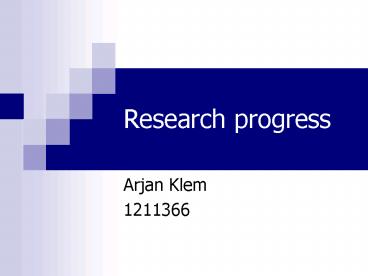Research progress PowerPoint PPT Presentation
1 / 19
Title: Research progress
1
Research progress
- Arjan Klem
- 1211366
2
Concept hypothesis
- To find a way to create a concrete structural
façade, using a bone structure as inspiration, - A bone structure is very light, but very strong,
because there is only material where it is
needed, so the shape is adapted to the forces
applied to it. - Advantages Lightweight, strong, use of less
material.
3
- Topology optimization Optimize a shape to the
forces applied to it, using the minimum amount of
material. - A free 2d example program was used to experiment
a little with this. - www.topopt.dtu.dk
4
- Things I had to do
- - Calculate the forces on a
- standard building
- - Find a optimization program to
- calculate the façade of this
- building
- The building
- 20x20x12 meters
- Wind load 1kN/m²
- Chosen façade thickness 300mm
- - This resulted in the input for a program
5
- As the optimization program I use Diana with a
optimization script I received from
dr. ir. Max Hendriks, who has done some research
about optimization in Diana. - Now I had to model the input.
Optimization in Diana, Max hendriks, May 2007
6
- Some factors are affecting the results
- Mesh Type (triangular/Quadratic)
- Mesh division (fineraccurate but slow)
- Number of iterations Every node can be
reduced 7 times so the maximum number of
iterations is 7nodes. Sow a finer mesh causes
exponentionally more calculating time.
7
(No Transcript)
8
- The results of the basic model were satisfying,
so I started to develop some variants to explore
the possibilities.
9
(No Transcript)
10
(No Transcript)
11
Interpretation 1. Making windows in the blue
areas using a grid.
12
2. Random openings using a grid, ignoring the
outcome from the earlier calculations
13
3. Creating smoothed openings, following the blue
areas in the original calculation.
14
Materialization
1. Every element that is used less then 50 will
be deleted and every element used more than
50will be the full thickness of the wall. This
results in hard edges Structure/no structure
15
2. Same as model 1, but the edges are smoothed.
16
3. The wall is built in layers, with the most
loaded elements (red in Diana) as the thickest
part and the least loaded elements as the
thinnest. The wall is solid and doesnt contain
windows.
17
4. Same as model 3, but the thinnest layer is
transparent, so the openings in the façade are a
result of the structure
18
General conclusion This way of designing is
suitable in situations where the material is put
to the limit, like -High rise (material and
weight reduction, while maintaining
strength) -Uncommon structures like
overhangs This way of designing is very flexible
and gives an extra degree of freedom in designing
the building.
19
- Recommendations
- This research also results in some questions that
should be investigated - How should these structures be created
- What solution of materialization has the best
mechanical properties - What solution of materialization has the best
transparency - Is it possible to use different materials (one
for compression and one for tension for
example)

